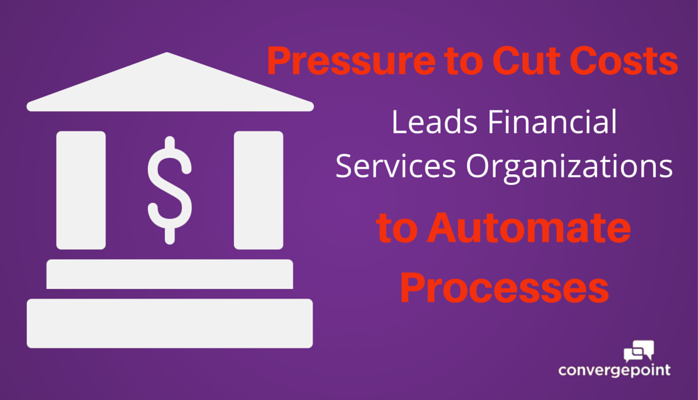Pressure to Cut Costs Leads Financial Services Organizations to Automate Processes

Today, financial institutions are continually pressured to decrease costs while increasing profitability. On top of these tasks, they must juggle demanding customers looking for faster, more personalized service, safeguarding against cybersecurity attacks and adhering to regulatory compliance standards.
To meet these demands, banks, credit unions and other financial services organizations have focused on creating and improving processes through automation. Process automation allows them to:
- Draft, execute and fulfill contracts with vendors and suppliers more quickly, enabling for faster delivery of products and services, which helps attract and retain customers looking for faster, personalized service
- Quickly adapt policies, processes and procedures to evolving regulatory standards, market conditions and customer expectations
- Eliminate manual management of deadlines for policies, procedures and contracts
- Monitor workflows and status of contracts, policies and procedures through real-time dashboards and ad hoc reports, which offer insight into how processes impact business goals, where bottlenecks occur and areas of improvement
What platforms or systems are financial institutions using to automate their processes? Many financial institutions already have SharePoint, but haven’t maximized its potential for improving policy and contract workflows. In fact, recent Association of Information and Image Management (AIIM) survey respondents labeled SharePoint “best in show” for team collaboration and content management — meaning they have a strong commitment to making SharePoint work, but aren’t sure how to go about making the most of it.
Not to be mistaken as an application, SharePoint is a platform that requires “integration with other enterprise systems and third-party systems to fill out its functionality,” according to a recent CMSWire article.
In other words, policy and contract processes can be automated using SharePoint, but only if organizations plan correctly and are dedicated to making SharePoint work properly — and to do so, they need to:
- Partner with a third-party software vendor who will ensure that SharePoint is configured to meet their needs and mirror their processes
- Determine goals for the software, what processes they want automated and who should be involved in the project
- Take ownership of the project, and ensure senior management and end-users are committed to using the software
- Develop a reasonable deployment, implementation and training schedule
- Allocate time and resources to user training
With increasingly strict regulations and customer demands, financial institutions have unique requirements for policy management software and contract management software. Among the top three concerns, SharePoint addresses:
- With multiple branches or locations, you need a system that will store all documents in one central location, while allowing you to control who has access to which documents using integration with Active Directory Groups. For example, employees at Branch A should be able to see the corporate/administrative office’s documents and Branch A’s documents, but not Branch B – E’s documents.
- Mitigate risks by developing contracts with vendors and suppliers that clearly define responsibilities to help ensure the contract’s enforceability and limit your liability. With advanced document approval workflows, a contract management system helps ensure all the right people review the contract before it’s signed and executed.
- Capture and maintain full document audit trails, including version histories, comments, discussions and revisions, for compliance purposes
To see how a correctly configured SharePoint system can mirror your processes and automate your workflows, schedule a free, no-obligation demo with us:
Industries served
Manufacturing and Retail Industry
Many manufacturing and retail companies have a decentralized business model with
Healthcare
The healthcare industry encompasses a wide range of facilities from hospital
Financial Services and Banking
Every organization in the financial service industry — whether a commercial bank,
Insurance and Employee Benefits
The insurance and employee benefits industry knows more than anyone else
Energy and Utilities
Navigating the increasingly complex regulatory requirements can be tough for
Transportation
Abide by FAA, DOT, FMCSA, FRA and FTA regulations, educate drivers and third party vendors on guidelines, and streamline overall compliance.
